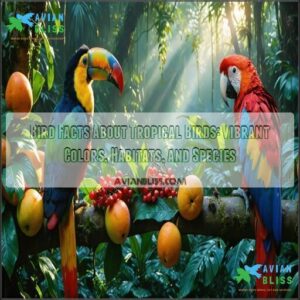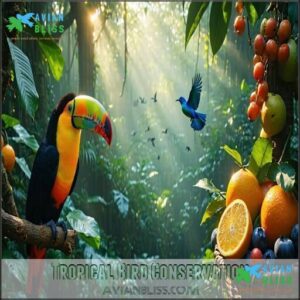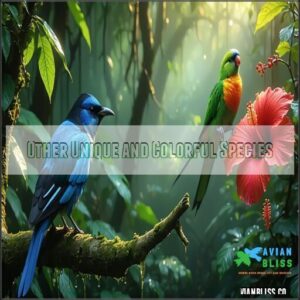This site is supported by our readers. We may earn a commission, at no cost to you, if you purchase through links.

Their bright colors, like the emerald green of the quetzal or the scarlet red of macaws, help them blend into lush rainforests or attract mates.
Many have specialized beaks, like the toucan’s iconic orange bill, perfect for eating fruit, insects, and seeds.
They’re highly social and often communicate through loud calls or even intricate courtship dances.
These birds thrive in tropical habitats but face threats like deforestation and climate change.
Curious about their intelligence or adaptations? Let’s uncover more!
Table Of Contents
- Key Takeaways
- Tropical Bird Characteristics
- Tropical Bird Behavior
- Tropical Bird Conservation
- Notable Tropical Bird Species
- Tropical Bird Anatomy and Physiology
- Frequently Asked Questions (FAQs)
- What are 5 bird characteristics?
- What was the first bird in the world?
- What is the ugliest bird in the world?
- What is the most beautiful bird in the world?
- What is the weirdest bird in the world?
- What are some facts about tropical birds?
- How do birds survive in the tropical rainforest?
- How do tropical birds stay cool?
- What kind of birds are on a tropical island?
- How do tropical birds navigate during migration?
- Conclusion
Key Takeaways
- You’ll notice tropical birds are colorful birds, with feathers and beaks adapted for survival in lush rainforests while attracting mates or eating fruit and seeds.
- They’re noisy communicators, using calls for territory, warning, or bonding, and some even mimic human speech or perform intricate dances.
- Tropical birds thrive in warm environments but face threats like deforestation and climate change, making conservation efforts essential.
- They’re highly intelligent, using tools and tricks to solve problems, which showcase their adaptability and learning abilities.
Tropical Bird Characteristics
Tropical birds are known for their bright colors, long bills, and remarkable intelligence. They inhabit warm climates and thrive in diverse ecosystems, from rainforests to savannas.
Bright colors and cunning minds make tropical birds the unmatched showstoppers of nature’s warmest, most vibrant ecosystems.
Bright Colors and Long Bills
Tropical birds have dazzling plumage that’s not just for show—it serves many purposes.
Their bright colors and long bills are adaptations for survival:
- Coloration Purpose: Plumage aids in camouflage or attracting mates.
- Bill Function: Long bills, like a toucan’s, help reach food.
- Bill Adaptations: Efficient feeding techniques.
- Plumage Evolution: Displays signal health for mating.
Omnivorous Diet and Eating Habits
Tropical birds thrive on dietary diversity, blending fruit preferences with insect consumption and seed predation.
Many omnivores, like toucans and parrots, adapt their bird diet based on seasonal availability.
Some display scavenging behavior for protein-rich snacks, balancing plants and small animals.
This mix guarantees survival and energy, revealing just how flexible these vibrant creatures are in sourcing their meals with a blend of plants and small animals.
Unique Environments and Habitats
Bird habitats are as diverse as their colors.
From lush jungle ecosystems and vibrant tropical rainforests to open savanna habitats and misty mountain grasslands, tropical birds thrive in warm, unique environments.
Island nesting and estuary locations also offer ideal tropical homes.
These habitats support extraordinary species, playing essential roles in maintaining the balance of biodiversity and ecological health.
Intelligence and Ability to Learn Tricks
Though small in size, these birds pack big brains! Their cognitive abilities shine through problem solving and tool use.
Many excel in social learning and mimicry skills, even replicating human speech. To boost their intelligence, engage them with bird enrichment activities—try teaching tricks or solving puzzles.
Some species, like crows, exhibit advanced problem-solving abilities.
- Mimics human speech with accuracy.
- Solves puzzles creatively.
- Learns tricks through repetition.
- Uses tools to retrieve food.
Tropical Bird Behavior
You’ll notice tropical birds are clever, curious, and full of energy. They use loud calls, social behaviors, and colorful displays to communicate, bond, and survive in their unique environments.
Noisy Communication and Screeching
You’ve probably heard a bird scream before—some species are particularly noisy.
Screeching is a form of communication, helping them bond, warn, or claim territory. Vocalization purposes differ, but the loudness impact varies across species.
One can also observe how hawk screams communicate territorial defense.
| Communication Range | Bird Sounds | Environmental Adaptation | Species Variation |
|---|---|---|---|
| Low to High | Screeches | Dense forests | Parrots |
| Broad | Chirps | Tropical mountains | Toucans |
| Localized | Squawks | Coastlines | Kingfishers |
| High-pitched | Screams | Rainforests | Macaws |
The loudness impact varies across species, and one can note the difference in vocalization purposes. The table highlights the variation in bird sounds and their environmental adaptation.
Social Behavior and Flocking
Flocking keeps tropical birds safer and fed.
Groups allow better predator avoidance through shared watchfulness, while flock communication helps locate food faster.
Social hierarchy organizes the flock, ensuring resources are shared effectively.
Some bird species migrate in flocks, following specific patterns for survival.
This bird behavior highlights teamwork, with foraging benefits making it clear why flocking is essential for tropical birds.
Courtship Displays and Elaborate Dances
Tropical birds captivate with courtship rituals that rival a ballroom performance.
Males often showcase vibrant plumage in dramatic feather displays, while others engage in unique mating rituals like elaborate dances or synchronized flights.
Vocal communication plays a pivotal role, using specific sounds for species recognition, highlighting the incredible dance evolution among tropical species.
This bird behavior blends beauty with evolutionary necessity, showcasing a remarkable example of evolutionary necessity.
Adaptations for Survival and Digestion
From flashy courtship dances, birds pivot to survival tactics.
Tropical birds exhibit remarkable adaptations, their dietary specializations allow foraging strategies like cracking seeds or gobbling fruit with large beaks.
Digestive efficiency supports nutrients from tough foods, and predator evasion includes swift flight and blending with foliage.
Climate resilience enables thriving in steamy habitats, and bird adaptations showcase a dynamic balance between survival and their diverse bird diet needs, highlighting the importance of tropical birds.
Tropical Bird Conservation
You play a pivotal role in protecting tropical birds, which face threats like deforestation and climate change. Supporting conservation efforts helps preserve these species and the biodiversity of their habitats.
Threats From Deforestation and Habitat Loss
Habitat loss and deforestation disrupt ecosystems, pushing tropical birds to fragmented spaces too small for survival.
Deforestation forces tropical birds into shrinking habitats, threatening their survival and the rich biodiversity they help sustain.
These changes lead to species endangerment as food, shelter, and breeding grounds vanish.
Agriculture, logging, and human development accelerate habitat fragmentation.
The consequences of deforestation include impacts on bird populations.
Endangered birds rely on conservation efforts and sustainable practices to restore ecosystems.
Protecting rainforests supports biodiversity and gives hope for tropical birds’ future.
Impact of Climate Change on Tropical Birds
Climate change hits tropical birds hard, causing habitat shifts, food scarcity, breeding changes, and even extinction risks.
Rising temperatures and altered rainfall patterns disrupt tropical ecosystems, threatening endangered birds. These shifts challenge survival, especially for species with specific needs.
The changing climate puts many at risk, with some studies suggesting potential extinction risks for numerous species.
Long-term bird conservation demands global conservation strategies and focused conservation efforts to preserve biodiversity in fragile tropical ecosystems, which is crucial for preventing extinction risks and ensuring the survival of these species through effective conservation.
Conservation Efforts and Protected Areas
Protecting tropical birds needs a hands-on approach.
Habitat restoration, nest boxes, and anti-poaching initiatives directly improve their bird conservation status.
Ecotourism impact supports local economies while encouraging awareness.
Community involvement also plays a big role, like Mexico’s bird monitoring networks.
Consider purchasing rainforest bird guides to learn more about these species.
These tropical bird conservation efforts help replace lost habitats and shield fragile populations from deforestation and illegal trade, securing their future.
Importance of Preserving Biodiversity
Tropical bird conservation efforts aren’t just about saving a single species.
Biodiversity supports ecosystem health, providing balance and strength in nature. Losing bird species diversity weakens this balance, leading to species extinction and fewer genetic resources.
Conservation benefits ripple across ecosystems, securing resources for future generations. Supporting conservation efforts is essential for these species.
Preserving tropical birds means protecting vibrant habitats, ensuring nature’s song continues for years to come, which is crucial for maintaining ecosystem health and biodiversity, and ultimately supporting conservation efforts.
Notable Tropical Bird Species
You’ll find some of the world’s most fascinating birds in tropical regions, each with unique traits.
From the emerald plumage of the Resplendent Quetzal to the Scarlet Macaw’s striking red feathers, these species showcase nature’s artistry.
Resplendent Quetzal and Its Emerald Plumage
The Resplendent Quetzal, with its emerald plumage, is a symbol of freedom in Mayan culture.
Found in cloud forest habitats, it’s a favorite among tropical birdwatchers.
This colorful bird’s long tail feathers make tropical bird identification easier.
Unfortunately, conservation status is a concern due to habitat loss.
Protecting these tropical birds guarantees their continued beauty in the wild.
Scarlet Macaw and Its Brilliant Red Feathers
The scarlet macaw’s brilliant red feathers captivate anyone lucky enough to see one.
Their colorful plumage reflects unique macaw plumage genetics.
Here’s what you should know:
- They live up to 50 years in the wild.
- Their diet includes fruits, nuts, and seeds.
- Macaw social behavior involves loud calls and close bonds.
- Conservation efforts protect their dwindling numbers.
Toco Toucan and Its Iconic Orange Beak
The Toco Toucan stands out with its large, vibrant orange beak, a remarkable example of beak evolution.
This feature isn’t just for looks—it aids in beak thermoregulation and showcases impressive beak strength.
Toucans primarily eat fruit, but their diet includes insects and small animals.
Found in tropical bird habitats, they use their beaks for toucan communication and foraging.
Other Unique and Colorful Species
Some exotic birds have unique traits that fascinate.
Here’s a list of colorful bird species you’ll love:
- Manakin: Known for its striking blue-black plumage and high-energy dances.
- Kagu: A rare, flightless bird from New Caledonia’s tropical habitats.
- Lorikeet: Features vibrant green and red splotches.
- Spoonbill: Conservation efforts protect these pink, wide-billed tropical birds.
Tropical Bird Anatomy and Physiology
Tropical birds have unique anatomy that supports their vibrant lifestyles, like efficient lungs for high oxygen demands and lightweight skeletons for flight.
Their specialized beaks and digestive systems help them adapt to a wide variety of foods in their diverse habitats.
Complex Lungs and Efficient Respiratory System
Tropical birds have incredible respiratory systems. Their lungs use unidirectional avian airflow, making bird respiration highly efficient.
Compared to mammals, their lung capacity allows near-continuous oxygen exchange, essential for flight.
Bird physiology includes air sacs for better gas exchange, while uric acid removal keeps weight low. The pneumatic bone system aids oxygen flow.
Did you know feather weight exceeds skeleton weight? Their anatomy is built for adaptation!
Unique Feathers and Skeletal System
Did you know a tropical bird’s feathers weigh more than its skeleton?
These lightweight bones and feather adaptations are what make flight so graceful. Their skeletal uniqueness allows strength with minimal weight.
Plus, those colorful feathers? They’re more than decoration.
- Feather Weight: Plumage often outmatches bone density.
- Plumage Coloration: Bright hues aid mating and camouflage.
- Flight Adaptations: Hollow bones boost energy efficiency.
Specialized Beaks and Digestive Systems
Birds don’t have teeth, so their beaks handle everything from cracking seeds to sipping nectar.
These specialized beaks are paired with digestion efficiency, breaking down fruit, insects, and seeds.
Macaws crush nuts with strong hooks, while nectar feeders have tongues uniquely designed for their diet.
This dietary specialization guarantees precise bird nutrition and adapts to diverse food sources across tropical habitats, ensuring the birds can efficiently process their food with digestion efficiency.
Fascinating Facts About Tropical Bird Biology
When exploring bird biology, tropical birds stand out with fascinating traits.
Their avian respiration is incredibly efficient, letting them thrive in tropical rainforests.
Using uric acid instead of urine conserves water.
A bird’s feathers often outweigh its skeleton—talk about lightweights!
Hummingbird flight is unique, as they’re the only ones to fly backward.
Toe-clench keeps them firmly perched.
Frequently Asked Questions (FAQs)
What are 5 bird characteristics?
It’s like nature’s genius at work!
Birds flaunt vibrant colors, unique feather patterns, lightweight bones for flight, highly efficient lungs, and sharp beaks adapted for feeding.
Every characteristic helps them thrive in diverse environments effortlessly.
What was the first bird in the world?
The first bird is believed to be Archaeopteryx, a feathered dinosaur that lived around 150 million years ago.
It had wings and feathers but also sharp claws and teeth, bridging dinosaurs and modern birds.
What is the ugliest bird in the world?
Beauty’s in the eye of the beholder, but the marabou stork often tops the "ugliest" lists.
With its bald head, scruffy feathers, and pendulous throat pouch, it looks like nature designed it for Halloween!
What is the most beautiful bird in the world?
The Resplendent Quetzal, with its emerald feathers and flowing tail, is often called the most beautiful bird.
It’s so vibrant and stunning that ancient Mayans considered it sacred, representing freedom and wealth.
What is the weirdest bird in the world?
With 60 species living on Earth, the Kagu stands out.
Found in New Caledonia, it can’t fly, has powdery feathers that repel water, and makes loud barking sounds—truly one of nature’s peculiar creations!
What are some facts about tropical birds?
Tropical birds shine with bright colors, live in warm regions, and eat a variety of foods from seeds to small animals.
They’re clever, noisy communicators, and often nest in tree holes or rocky cliffs.
How do birds survive in the tropical rainforest?
Think of the rainforest as a buffet and fortress combined.
Birds thrive on diverse food and dense shelter, using colorful feathers to signal mates or blend in.
Their sharp calls slice through the jungle’s symphony.
How do tropical birds stay cool?
To stay cool, birds often pant like dogs to release heat.
They perch in shady spots, fluff feathers to circulate air, and even bathe to reduce body temperature.
Some spread wings to catch breezes, which can be seen as a way to release heat.
What kind of birds are on a tropical island?
On a tropical island, you’d find colorful birds like parrots, toucans, and kingfishers.
These birds thrive in warm climates, blending vibrant plumage with loud calls.
They’re ecologically essential, helping pollinate plants and spread seeds, which makes them a crucial part of the ecosystem with vibrant plumage.
How do tropical birds navigate during migration?
They find their way using Earth’s magnetic field, stars, and the sun as landmarks.
Their instincts, paired with inherited knowledge and sharp navigation skills, guide them across thousands of miles to warmer breeding or feeding grounds, utilizing their instincts to navigate.
Conclusion
Over 30% of the world’s bird species are found in tropical regions, highlighting their vast diversity and ecological importance.
These birds’ bright colors, unique calls, and specialized beaks make them stand out.
They thrive in rich habitats but face threats like deforestation and climate change.
It’s necessary to protect these environments to guarantee their survival.
Tropical birds showcase nature’s creativity and resilience, and learning bird facts about tropical birds helps us appreciate their beauty and significance.
- http://udel.edu/~keenc/TropicalAnimals/tropicalbirds/tropicalbirds.html
- https://www.britannica.com/animal/tropic-bird
- https://www.nationalgeographic.com/animals/birds/facts/parrots
- https://kids.nationalgeographic.com/animals/birds/facts/indian-peafowl
- https://www.allaboutbirds.org/news/tropical-forest-bird-declines-climate-change/













